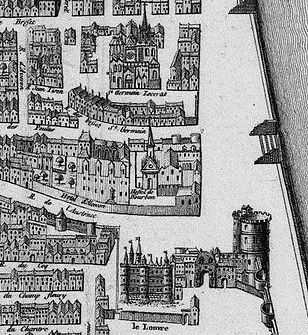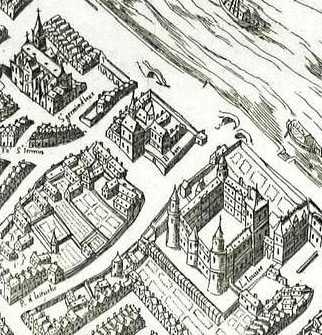Hôtel du Petit-Bourbon
Coordinates: 48°51′34″N 2°20′23″E / 48.85950°N 2.33970°E

The Hôtel du Petit-Bourbon, a former Parisian town house of the royal family of Bourbon, was constructed in the 14th century, not long after the Capetian Kings of France enlarged the fortress of the Louvre in order to use it as a royal residence. On two 1550 maps it is shown simply as the Hôtel de Bourbon, but by 1652, as the Petit-Bourbon on the map of Gomboust (see below).[1] It was located just east of the Louvre on the rue d'Autriche, a street which no longer exists.[2] The Bourbons took control of France in 1589, at which time they also acquired the Louvre. The great hall of the Petit-Bourbon, the Salle du Petit-Bourbon, was larger than any in the Louvre, and served as the first theatre of the troupe of Molière upon their arrival in Paris in 1658; but by 1660 Molière and his actors were evicted, and the Petit-Bourbon was pulled down to make space for the construction of Perrault's Colonnade as an addition to the Louvre.
History

When in the fourteenth century the kings of France began to use the Louvre as their primary Paris residence, courtiers needed to be in Paris in order to pay their respects to the King and to receive his favors. They therefore constructed magnificent town houses (hôtels particuliers) in the vicinity of the Louvre, very few of which have survived to the present day.[3]
According to Henri Sauval, from 1303 to 1404 the Bourbons purchased houses of more than 300 persons to assemble the site on which their new hotel was built. Over the years they augmented and embellished it such that it became one of the most magnificent in the kingdom.[4] Sauval describes the great hall and the chapel (which both still existed at the time he was writing), as the largest and most sumptuous of their kind in Paris.[5] The former was used for some of the celebrations accompanying the marriage of Louis XIII and many other court entertainments. The Estates General of 1614 and 1615 were also held there.[3]
In 1523 Charles III, Duke of Bourbon, who was Constable of France at the time, plotted to partition France against the will of King Francis I. When the plot was uncovered, Charles was forced to flee to Italy, and as a result the Hôtel de Bourbon was partly demolished. "Salt was strewed upon the ground which it occupied; the armorial ensigns of the offender were effaced, and the windows and doors that remained were smeared by the executioner with yellow ochre."[6]
The Petit-Bourbon on old maps of Paris
-

ca. 1550 (Truschet & Hoyau)
-

ca. 1550 (Saint Victor)
-

1609 (Quesnel)
-

1652 (Gomboust)
References
- Notes
- ↑ For the name Hôtel de Bourbon, see the Paris maps of Truschet & Hoyau (1550) and Saint Victor (1550); for the name Petit-Bourbon, see the map of Gomboust (1652). The latter also shows a street next to the Petit-Bourbon running perpendicular to the Louvre as the rue du Petit-Bourbon. This Hôtel de Bourbon should not be confused with one near the Église Saint-Sulpice on the Left Bank which belonged to the widow of Louis de Bourbon, Duke of Montpensier, and was also located on a street named rue du Petit-Bourbon (see Galignani 1825, vol. 2, p. 190, and Hare 1888, p. 406). The former rue du Petit-Bourbon near Saint-Sulpice is now the portion of the rue Saint-Sulpice which runs between the rue de Tournon and the rue Garancière and can be found on the full 1652 Gomboust map.
- ↑ Galignani 1825, vol. 2, p. 191, calls the street the rue d'Autriche. Other sources, e.g., Félibien 1725, p. 130, refer to it as the rue de l'Autruche.
- ↑ 3.0 3.1 Galignani 1825, vol.2, pp. 190–192.
- ↑ Sauval 1724, vol 2., p. 114.
- ↑ Sauval 1724, vol. 2, pp. 208–211.
- ↑ Galignani 1825, vol. 2, p. 191.
- Sources
| Wikimedia Commons has media related to Hôtel du Petit-Bourbon. |
- Félibien, Michel (1725). Histoire de la ville de Paris, vol. 4. Paris: Guillaume Desprez; Jean Desessartz. View at Google Books.
- Galignani, A.; Galignani, W., publishers (1825). The History of Paris from the Earliest Period to the Present Day, 3 volumes. Paris: A. and W. Galignani. Vols. 1 (2nd ed., 1832), 2 (1825), and 3 (1825) at Google Books.
- Hare, Augustus J.C. (1888). Walks in Paris. New York: George Routledge and Sons. View at Google Books.
- Sauval, Henri (1724). Histoire et recherches des antiquite's de la ville de Paris, 3 volumes. Paris: Charles Moette; Jacques Chardon. Vols. 1, 2 and 3 (copies 1 and 2) at Google Books.